Rare and unique birds exist on every continent on the planet. Human encroachment has endangered some of these species, while others only exist in specific habitats. Keep reading to learn about the twenty-five rarest birds that are still on the planet today.
1. Jabiru
This large stork is native to wetlands and riparian areas throughout Central and South America. They were considered “near threatened” in the 1980s due to overhunting, but their population has since stabilized. Jabiru birds have distinctive black heads and necks, white feathers on their bodies, and a red pouch at the base of their necks.
Jabirus form lifelong bonds with their mates and seek high places to build their nests. These birds often build nests and hunt in large groups. Jabirus prefer to eat fish and will wade into shallow waters to hunt for them. However, they will also eat snakes, insects, and even mice.

Jabiru birds have wingspans that can reach over 9 ft. in length.
©Rini Kools/Shutterstock.com
2. Galah
These members of the cockatoo family sport bright pink feathers on their breasts, faces, and necks. They are only found in Australia, although they are relatively common within grassy areas and woodlands.
Galahs often gather in large groups and even mingle with other species of birds. They will forage in large numbers for the seeds and leaves they depend on for food.
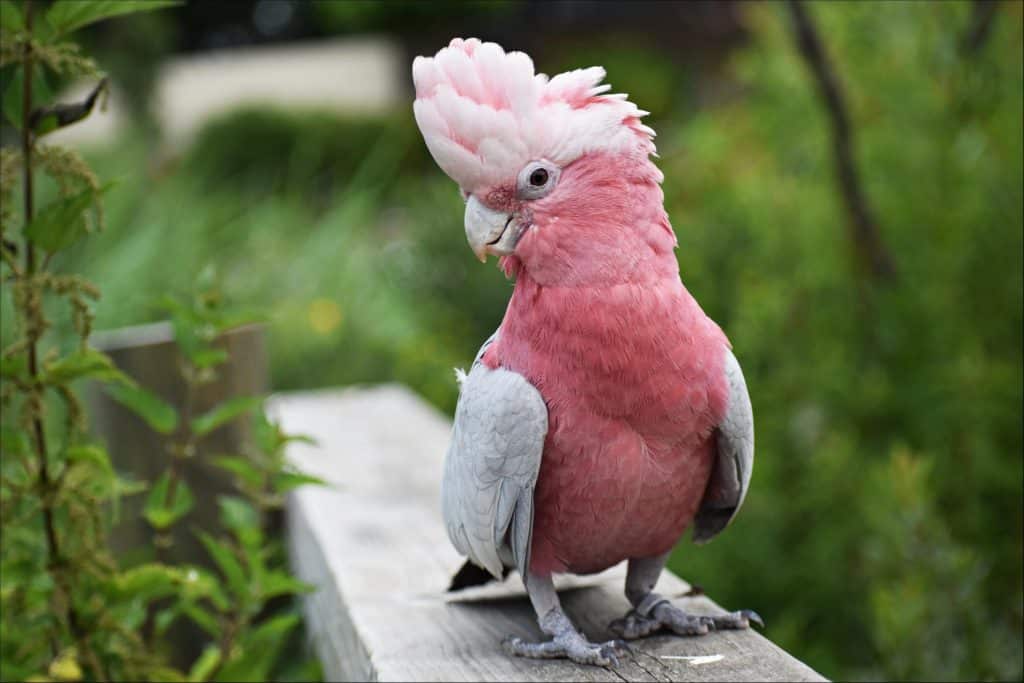
Galah cockatoos feed on leaves, which can result in tree death.
©Gabriela Beres/Shutterstock.com
3. Vogelkop Superb Bird-Of-Paradise
These breathtaking birds are only found in New Guinea on Vogelkop Island. There are over 45 different types of birds of paradise, known for their colorful plumage and intricate mating rituals.
The male Vogelkop Superb Bird-of-Paradise attracts a partner by putting up a semi-circle of black feathers, which draw attention to its blue breast feathers. They are not endangered, but they are one of the world’s rarest birds due to their limited habitat.
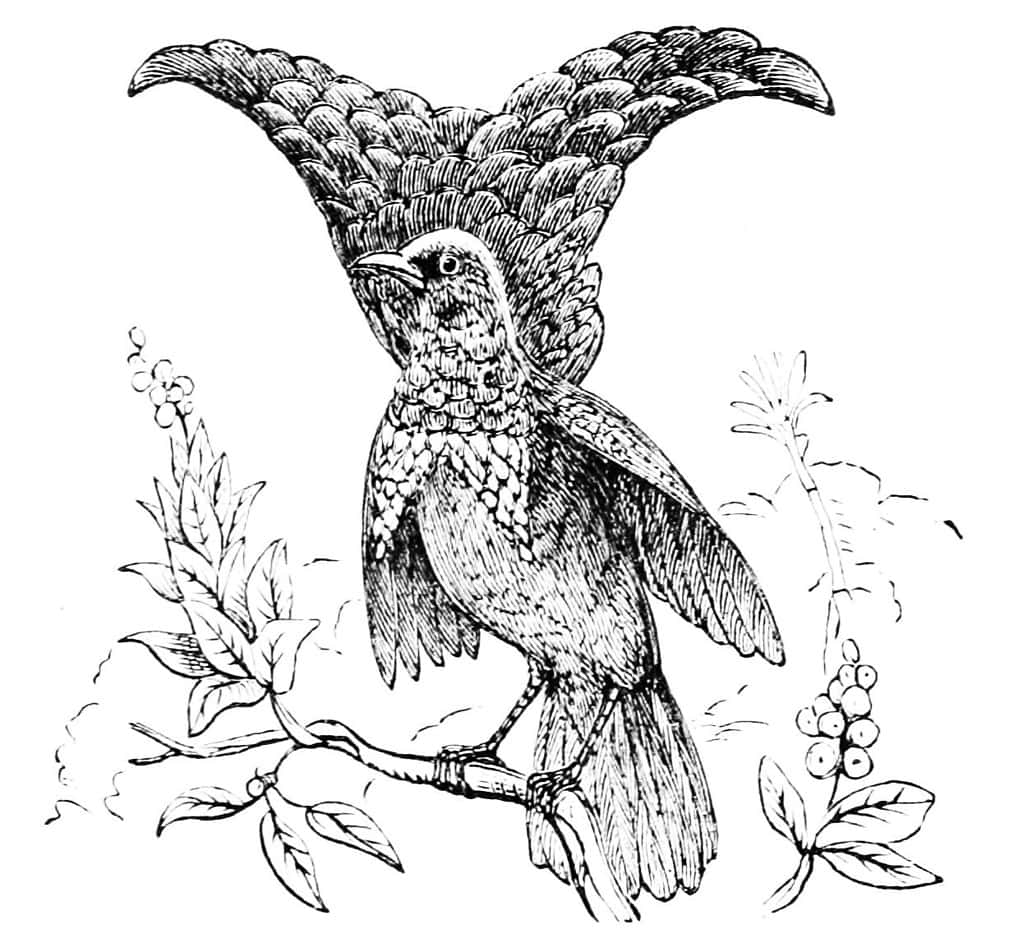
Vogelkop Superb Bird-of-Paradise are not endangered, but they are one of the world’s rarest birds due to their limited habitat.
©Popular Science Monthly Volume 5, Public domain, via Wikimedia Commons – License
4. Imperial Amazon Parrot
There are several different types of Amazon parrots, and the imperial Amazon parrot is among the rarest. The IUCN Red List says that these birds are critically endangered, with only between 40 and 60 imperial Amazon parrots remaining.
Imperial Amazon parrots are located in Dominica, where they are the country’s national bird. These birds can reach lengths of up to 19 in. and have multi-colored feathers that include red, orange, green, and blue. They eat nuts and seeds, which they crack open with their large, hooked bills.
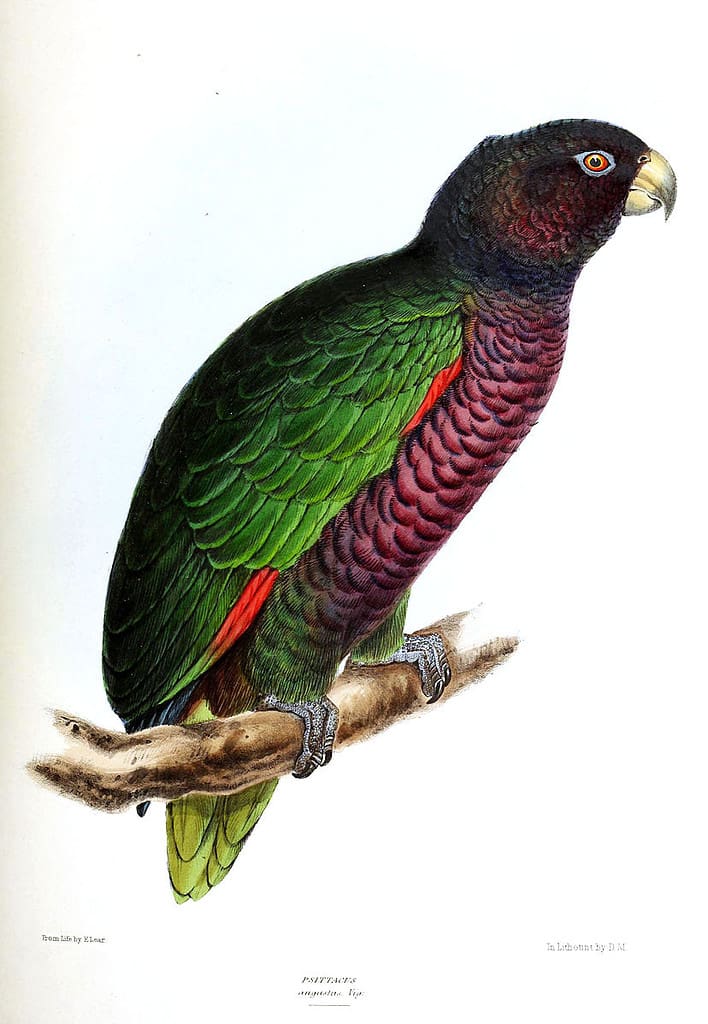
Illustration of the imperial Amazon parrot by English zoologist David William Mitchell.
©David William Mitchell (1813–1859), Public domain, via Wikimedia Commons – License
5. California Condor
Boasting a wingspan of up to 9 ft., the California condor is the biggest bird in North America. These birds have been in existence for at least 40,000 years. However, there are fewer than 100 mature adult condors remaining, making them critically endangered.
These birds mate for life and find nesting spots along cliffsides or inside caves. Their diets consist primarily of carrion, and they will travel in the air for miles in search of animal carcasses. The California Condor population dropped significantly in the 20th century due to the birds ingesting fragments of lead bullets. They are also at risk due to their dwindling habitat, pollution, and viruses.
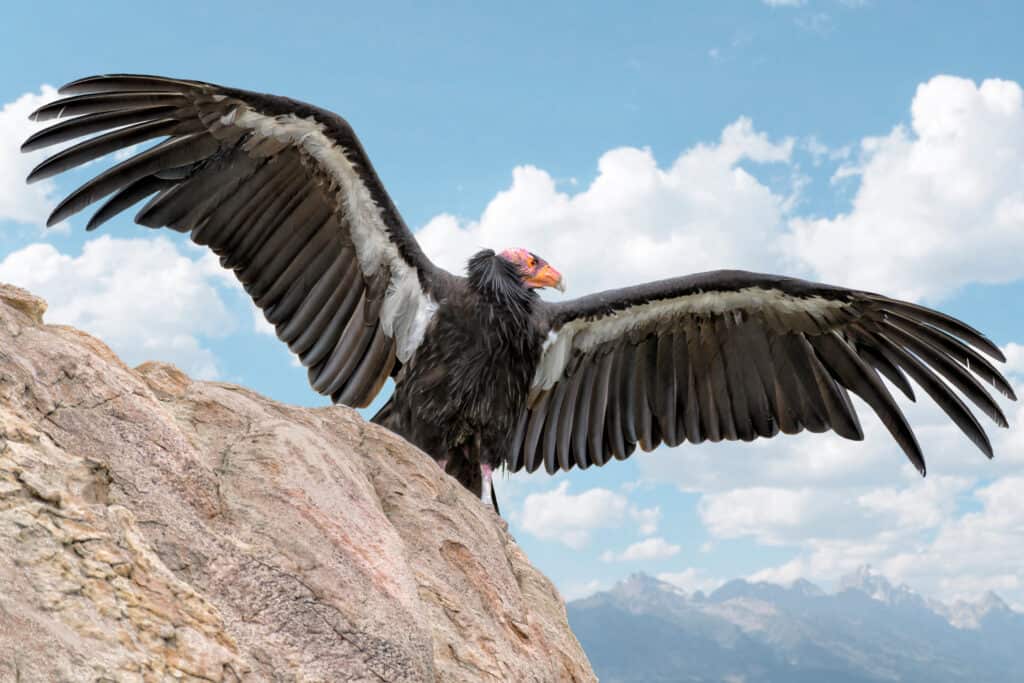
Female California condors lay only a single egg at a time and then must wait over a year to breed again.
©Barbara Ash/Shutterstock.com
6. African Grey Parrot
These birds demonstrate high levels of intelligence and are well-known for their ability to speak. Their high demand in the pet trade is largely responsible for endangering African grey parrots.
In the wild, African Grey Parrots are native to central and western Africa. They build nests inside trees with their life-long mates. These birds are largely herbivorous, with diets that consist mainly of fruits, nuts, and bark.
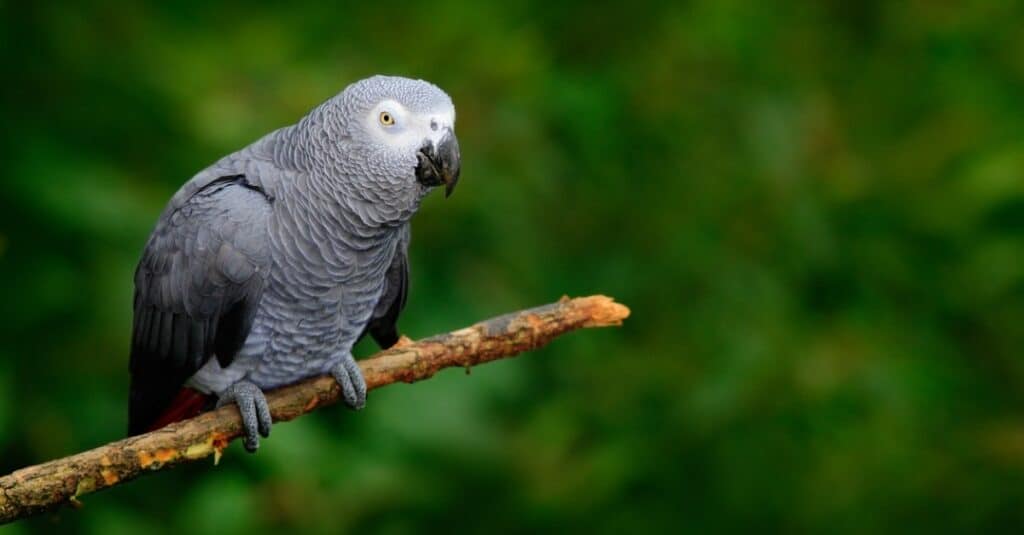
Wild African grey parrots have an average lifespan of 23 years; in captivity, their lifespan increases to 60 years or more.
©iStock.com/Ondrej Prosicky
7. Rufous Hummingbird
These orange-colored hummingbirds are classified as near threatened by the IUCN, and their population is trending downward. Rufous Hummingbirds are migratory and travel between Mexico and northern parts of the United States and Canada.
They rely on native wildflowers for food, using their wings to hover in the air while probing for nectar. Rufous Hummingbirds also eat insects, and pesticides have resulted in fewer bugs for them to eat. They also face food shortages when flowers bloom before they begin migrating, leaving the birds with limited options for sustenance.

Rufous Hummingbirds are about three inches long when fully grown.
©Keneva Photography/Shutterstock.com
8. Ivory-Billed Woodpecker
These birds are considered critically endangered, and experts estimate there are fewer than 50 mature adult ivory-billed woodpeckers remaining. Scientists thought the species was extinct in the 1990s. However, unconfirmed sightings have given researchers hope that these rare birds may still exist in the forests and swamps of the southeastern U.S. and Cuba.
Ivory-billed woodpeckers use their beaks to create holes in tree trunks where they build nests. Deforestation of their native habitats had a severe impact on their population.
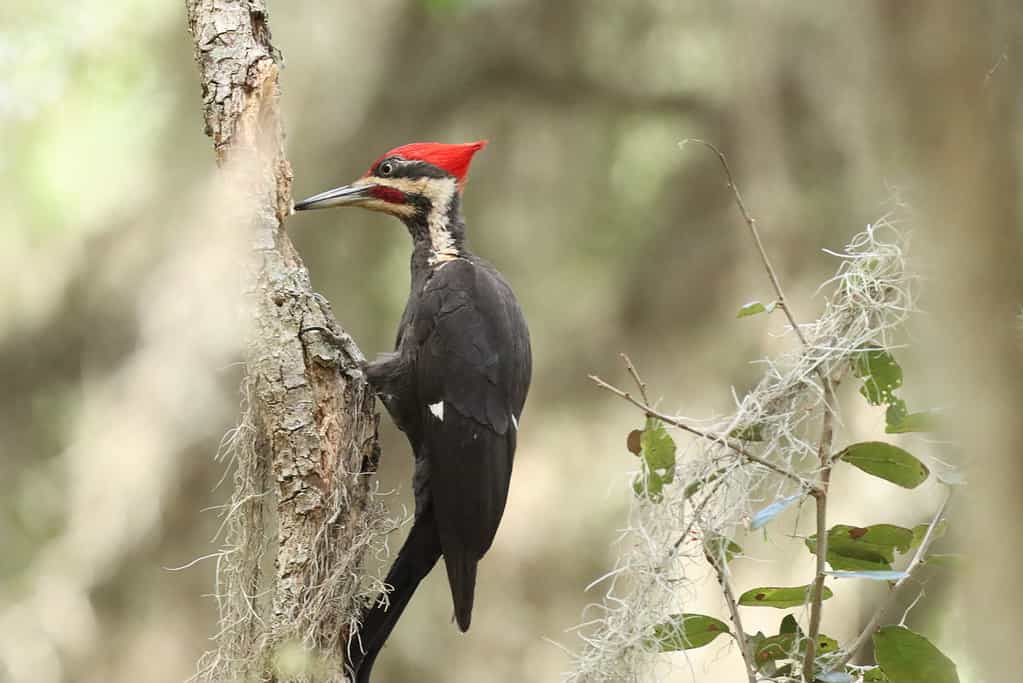
Ivory-billed woodpeckers do not migrate, electing to stay close to their nests.
©Wirestock/iStock via Getty Images
9. Yellow-Eyed Penguin
Only found in the coastal regions of New Zealand, Yellow-Eyed Penguins are the rarest species of penguin on the planet. They are considered endangered, with an estimated 3,000 mature individuals.
These diminutive birds grow to around 11 to 13 lbs. and reach heights of about 24 in. Adults have distinctive yellow eyeballs as well as yellow feathers on their heads. The Maori people of New Zealand called this bird Hoiho, meaning “noise shouter,” for the volume of its calls.
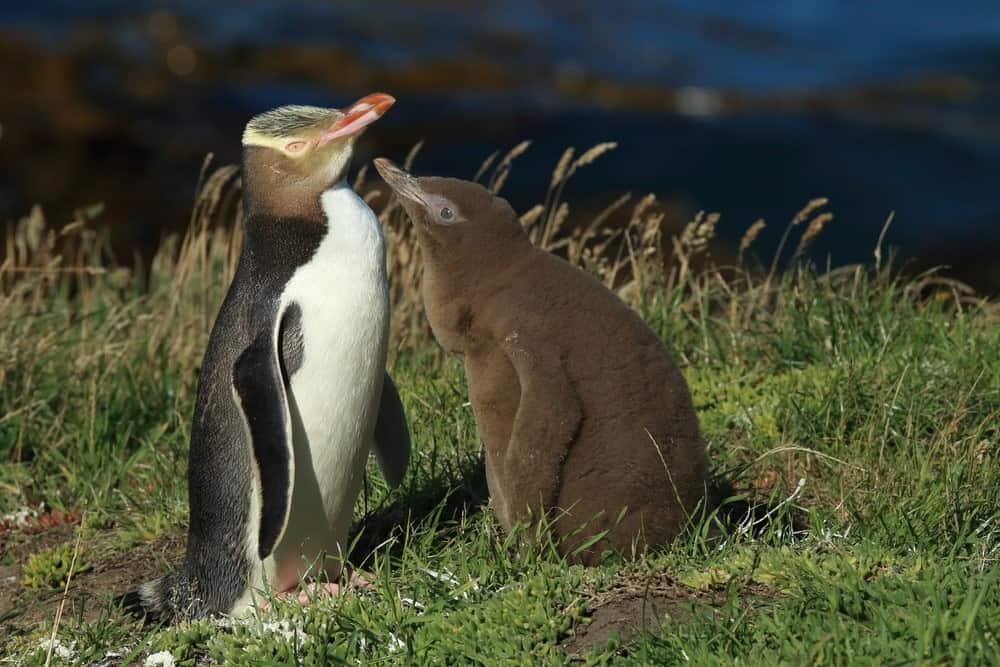
Yellow-eyed penguins lost about 60% of their population in 2004 due to a bacterial infection.
©Frank Fichtmueller/Shutterstock.com
10. Red-Headed Vulture
These fierce-looking birds are mostly found in India, Nepal, and Bangladesh, although their numbers are declining. Despite their appearance, Red-Headed Vultures are not aggressive and will abandon their meal if intimidated by other birds.
In the sky, red-headed vultures have impressive flying abilities. Their mating ritual includes spectacular mid-air displays where two birds will dive, swoop, and twist together. Medications used to treat illnesses in livestock have threatened their population. Red-headed vultures eat mostly carrion, and the medication in livestock carcasses caused widespread poisoning in the birds.

Both male and female red-headed vultures actively participate in raising their offspring.
©faisal magnet/Shutterstock.com
11. Kakapo
The kakapo is another of New Zealand’s rare birds. For millions of years, the kakapo had very few predators. However, that changed as other animals were introduced to the island nation and started hunting kakapos, which greatly reduced their numbers.
These large, flightless birds are also nocturnal, emerging at night to forage for fruits, seeds, and plant shoots. Despite being unable to fly, kakapo can climb trees with their eet, and then use their relatively small wings to glide back down to the ground.
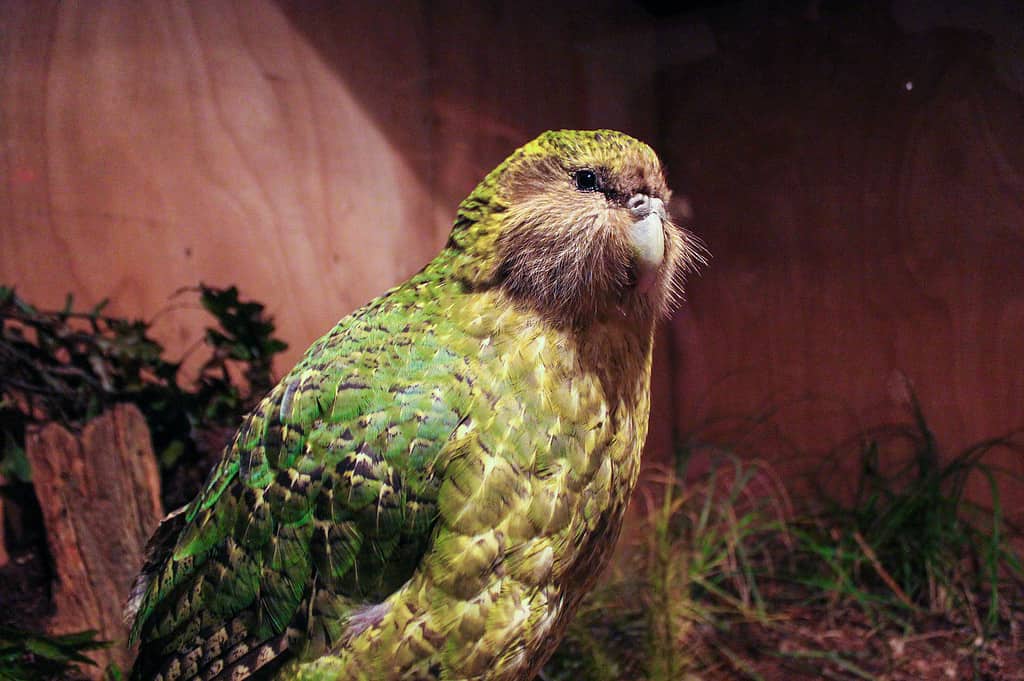
Kakapos can weigh up to 9 pounds, making them the world’s largest species of parrot.
©Imogen Warren/Shutterstock.com
12. Philippine Eagle
This bird is native to the Philippines, where it is the country’s national bird. The Philippine eagle is critically endangered, however, and experts estimate that fewer than 500 remain.
These rare birds are among the world’s largest species of eagles. They can reach heights of 3 feet with wingspans of 6.5 feet. Philippine eagles can be recognized by their distinctive brown and white crest, which circles their heads like a mane.
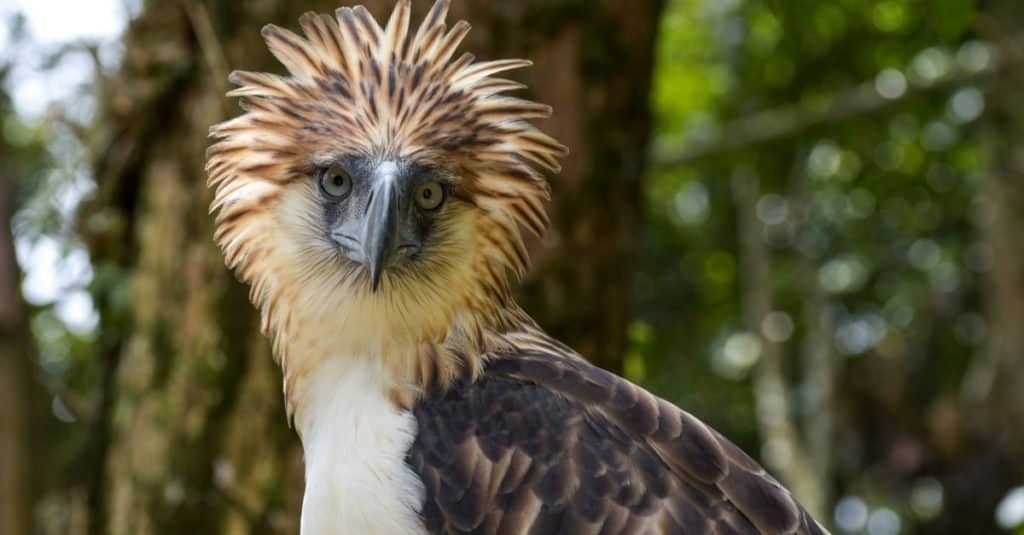
The Philippine eagle was formerly called the “monkey-eating eagle,” but their diet consists of mammals, small reptiles, and other birds.
©Michal Lukaszewicz/Shutterstock.com
13. Emperor Penguin
These birds are native to Antarctica and are the world’s largest species of penguin. Emperor penguins cannot fly but they use their small wings to swim through icy waters. Their well-adapted body shape allows them to easily swim, and they can hold their breath underwater for up to 20 minutes.
To survive the frigid Antarctic conditions, emperor penguins have specialized feathers and a layer of fat to keep them warm. They are also social birds, living together in colonies and huddling for warmth during the coldest months. Emperor penguin populations are reducing due to shifts in their habitat and climate.

Unlike other penguins, emperor penguins lay their eggs during the coldest months of the year.
©Michel VIARD/ via Getty Images
14. Wandering Albatross
With the largest wingspan of any bird, the wandering albatross can spend hours at a time in flight. On average, they can have 9 ft. wingspans and reach weights of 14 to 26 lbs.
The wandering albatross is native to the coastal areas of New Zealand, Africa, Australia, and Antarctica. They soar over the ocean waters in search of seafood such as fish, shrimp, and squid. When wandering albatrosses fledge and leave their nests, they can spend a decade at sea before returning to solid ground to breed.

In flight, the wandering
albatross
can reach top speeds of almost 70 mph.
©Imogen Warren/Shutterstock.com
15. Egyptian Vulture
Although they can be found in areas of Africa, Europe, and Asia, these rare birds are endangered, and their numbers are declining. Egyptian vultures inhabit deserts and fields in southern Europe, northern Africa, and southwestern Asia, where they breed, before traveling to the southern Sahara desert for the winter months.
Egyptian vultures prefer to stay in proximity to humans so they can supplement their carrion-based diets with refuse from slaughterhouses and fishing ports. These birds will even steal eggs from other birds, opening them with rocks to eat the contents inside. Reduced habitat and contaminated food sources are the main threats that endanger these birds.
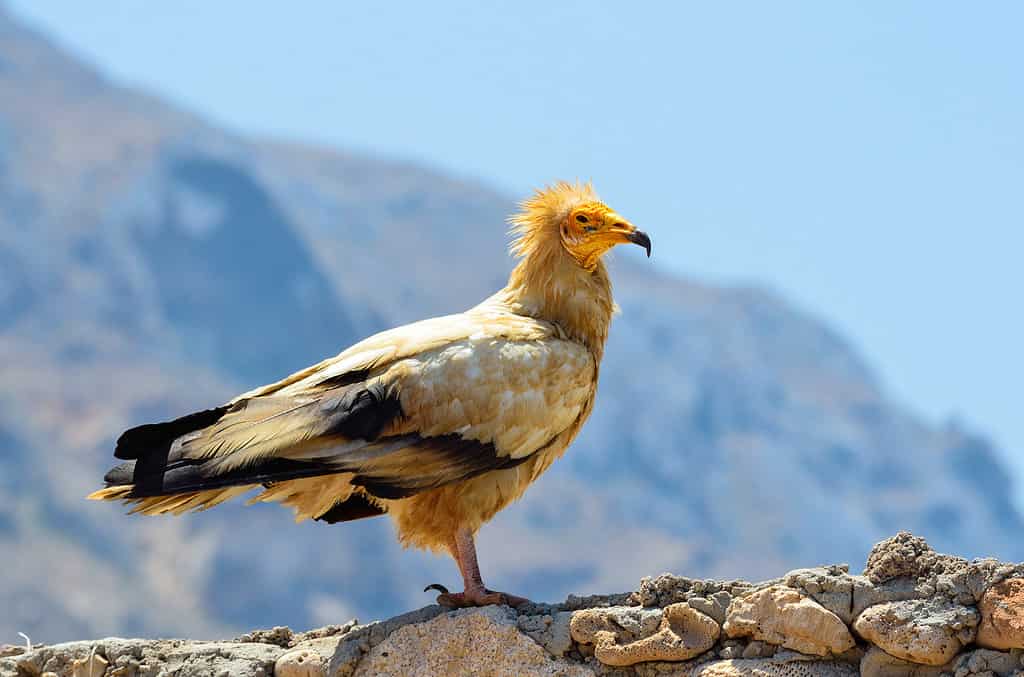
Egyptian vultures can fly up to 300 miles in a day.
©irinabal18/ via Getty Images
16. Red Kite
These birds have distinctive forked tails, which they use to steer themselves during flight. Red kites are strong aviators, easily diving and soaring through the air. These birds are native to Europe, as well as parts of Asia and northern Africa, where they primarily inhabit grasslands, forests, and wetlands.
Red kites are carnivores, preferring to eat small mammals and fish. However, they will also eat carrion. Their numbers are threatened due to the impacts of poison that some farmers put out for mice and rodents, which can be fatal to red kites.

Some red kites in northern regions will migrate south for the winter, but others stay in the same area year-round.
©Werner Baumgarten/Shutterstock.com
17. Orange-Bellied Parrot
With declining numbers and limited native habitat, orange-bellied parrots are critically endangered. Experts estimate there are only 20 to 25 adults of this species left in the wild.
These birds are only found around the southern coast of Australia, where they prefer to inhabit wetlands and forests. They migrate to Tasmania to breed and then return to Australia for the winter months.
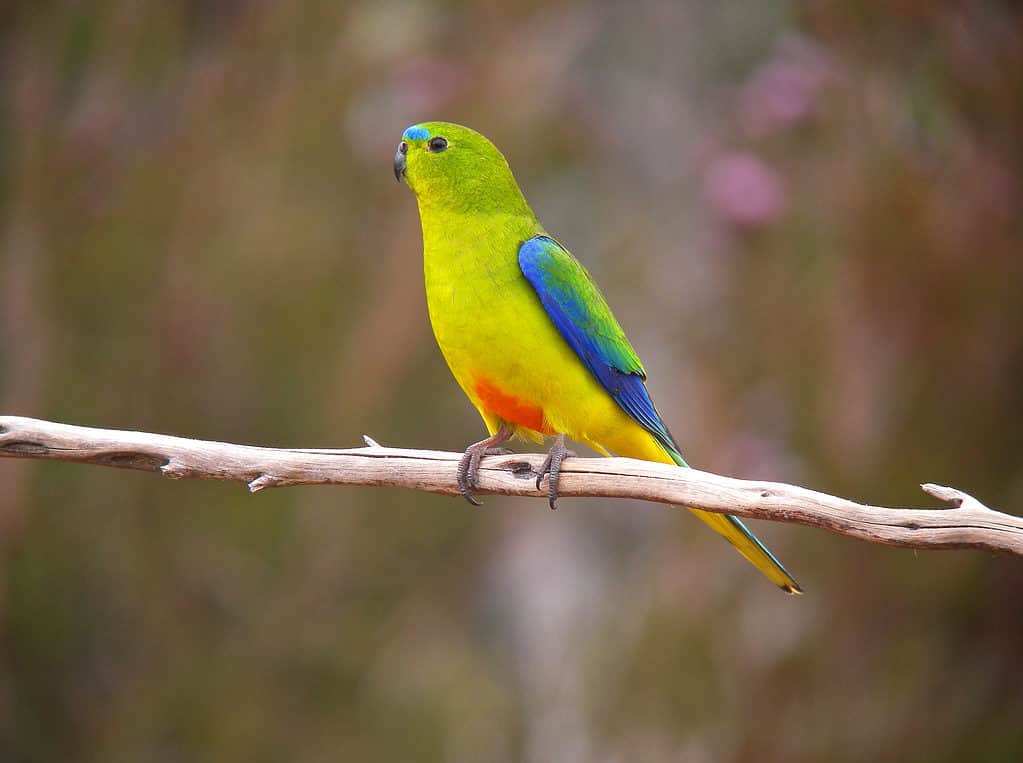
Experts are breeding orange-bellied parrots in captivity in an attempt to preserve the species.
©Agami Photo Agency/Shutterstock.com
18. Harpy Eagle
These fierce-looking birds have a distinctive crown of feathers they raise when they feel threatened. The harpy eagle is one of the world’s largest species of eagles, and its talons can reach lengths of 3 to 4 in., rivaling the size of a grizzly bear’s claws.
Harpy eagles are remarkable hunters and can spot prey on the forest floor from hundreds of feet away. They primarily inhabit tropical rainforests of South and Central America, where they hunt sloths, monkeys, rodents, and other small animals.
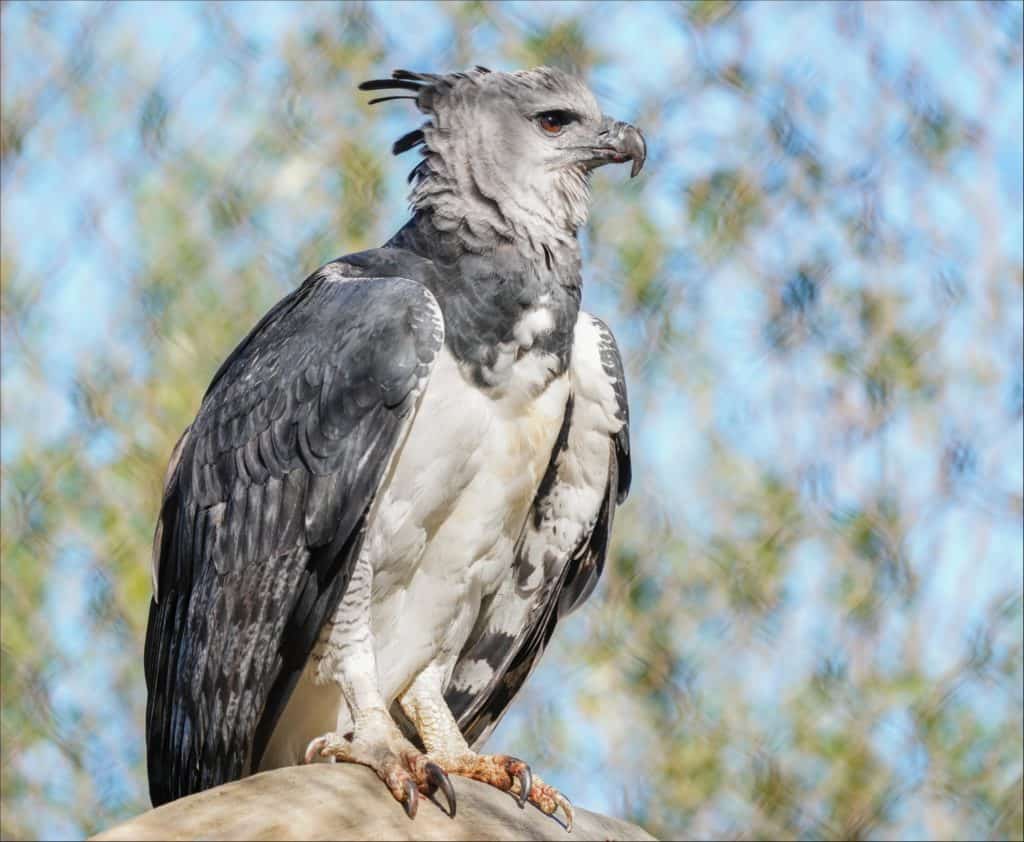
Harpy eagles build nests that are often 100 ft. off the ground, high above potential predators.
©TIKO IGITYAN/Shutterstock.com
19. Kagu
These birds are native to the Pacific island of New Caledonia. Kagu birds inhabit a small part of the island, preferring to live and hunt in rainforests or shrublands. They are considered endangered, with fewer than 1,000 adults estimated to remain in the wild.
Kagu birds are recognized by their distinctive crest feathers. These birds are flightless carnivores and search the forest floor for worms, insects, and lizards. These rare birds are the only species with nasal corns, which prevent them from inhaling dust and debris as they use their beaks to forage for food.
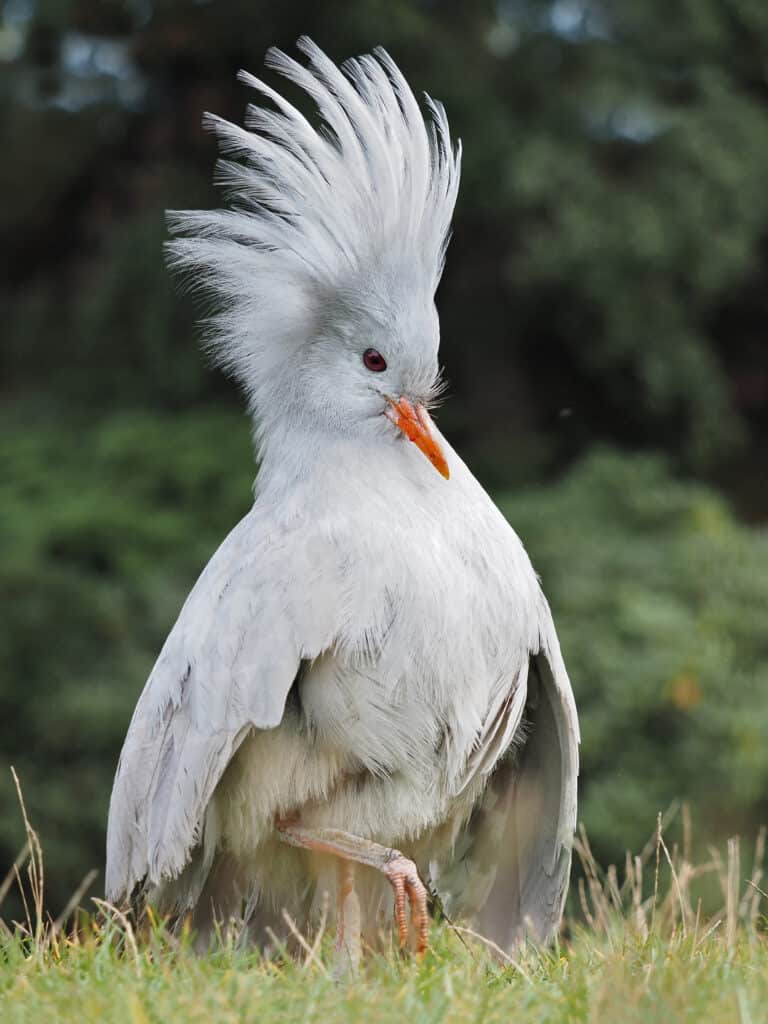
Kagu chicks may leave their nests after only three days but return to their parents for feeding until they are 14 weeks old.
©Holger Kirk/Shutterstock.com
20. Great Hornbill
Among the largest of the hornbill species, the great hornbill is found mainly in evergreen forests in Southeast Asia. These birds can weigh over 6 lbs. and can have wingspans of over 5 ft.
Great hornbills use their loud, frequent calls to attract mates. These birds are recognizable by the unique casque on their bills. This hollow, U-shaped structure may be used to attract mates, or it may amplify the bird’s calls.

Great hornbills don’t drink water, instead receiving hydration through their diet.
©Sunti/Shutterstock.com
21. Scarlet Macaw
These large, colorful parrots are known for their ability to vocalize and imitate human speech. These birds are found in the tropical rainforests of Central and South America, where they build nests in the upper tree canopy.
Scarlet macaws have been raised in captivity for thousands of years, and historically, their feathers were highly valued for ceremonial uses. These intelligent birds use their strong beaks to climb trees to reach their preferred diet of fruits, nuts, seeds, and occasional insect larvae.
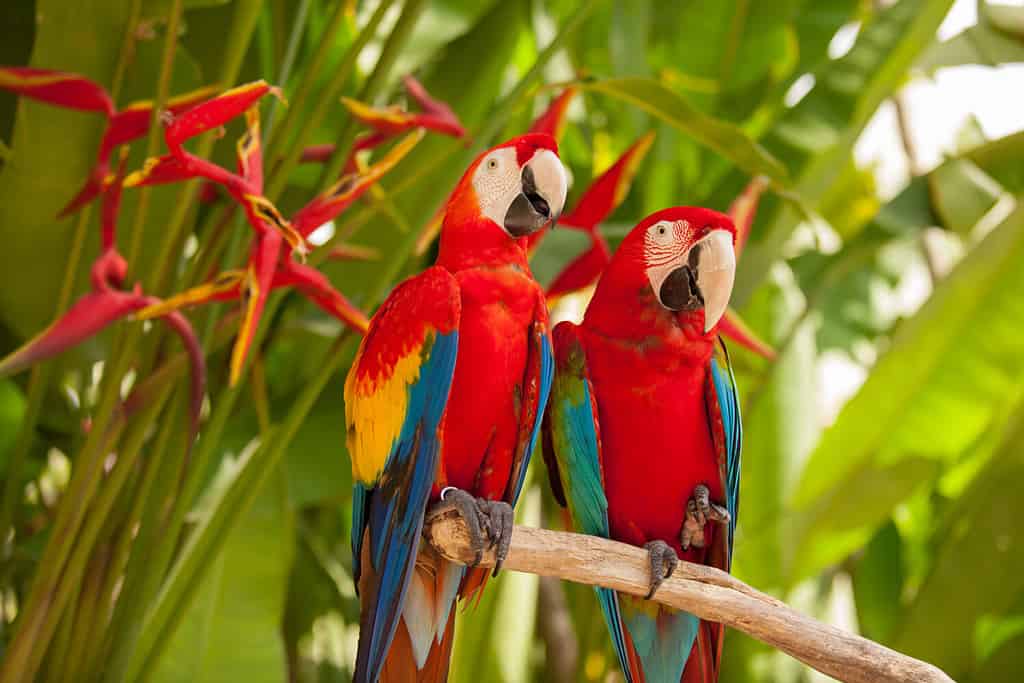
Scarlet macaws are affectionate with their mates and can spend hours licking and preening each other.
©Katia Titova/Shutterstock.com
22. Toco Toucan
These birds are native to areas of Brazil, Argentina, Paraguay, and Bolivia, where they inhabit shrublands, savannahs, and some forest territory. Their distinctive beaks are hollow but feature sharp edges that the toco toucan uses to bite into fruit, insects, and even small reptiles.
Toco toucan’s beaks are brightly colored and can account for a third of the toucan’s body length. They also have blue feet, which feature two backward-facing toes, which allow the toco toucans to easily grasp tree branches.
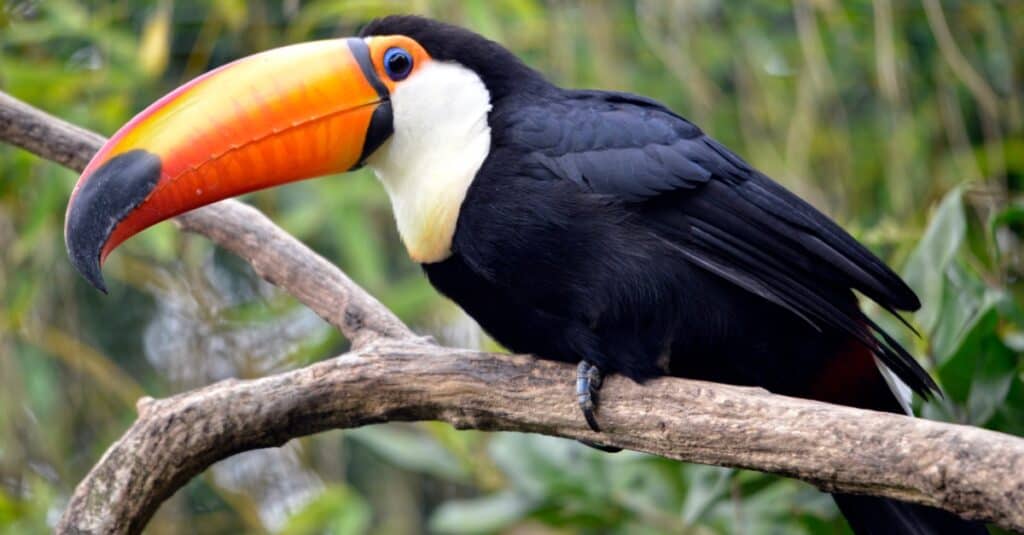
Toucans build their nests inside holes they find in trees — holes that are often created by other birds.
©iStock.com/Musat
23. Hawaiian Crow
The Hawaiian crow is extinct in the wild, although conservations are working to restore the bird’s habitat and breed them in captivity. Historically, native Hawaiians considered this bird to be the island’s guardian spirit.
Hawaiian crows are highly intelligent, and researchers have discovered that these birds have excellent memories and the ability to use basic tools. These birds are also highly vocal, displaying a wide range of loud and sometimes harsh calls that include howls and screeches.

Hawaiian crows are omnivores with wide-ranging diets, including fruits, snails, spiders, and occasionally carrion.
©U.S. Fish and Wildlife Service / public domain – License
24. Whooping Crane
Once abundant in North America, the whooping crane is now considered endangered, with fewer than 250 adults remaining. Its habitat includes marshes and wetlands where they create low, mounded nests close to water.
The whooping crane is the tallest North American bird, reaching heights of 5 ft. Their feathers are almost entirely white, except for black feathers at their wingtips and a red patch on the top of their heads. These birds embark on an annual migration that can take them a staggering 2,500 miles from Canada and the northern United States to areas in Texas or Florida.

The
whooping crane
gets its name from its distinctive, loud calls.
©Kent Ellington/Shutterstock.com
25. Spanish Imperial Eagle
Native to Spain and parts of Portugal, the imperial eagle is Spain’s national bird. These birds are also vulnerable to extinction, and experts estimate there are only about 1,000 remaining in the wild. Spanish imperial eagles avoid humans and prefer to build nests in tall pine trees.
These birds possess dark brown feathers that may occasionally feature lighter brown or rust-colored accents. They can be recognized by a white band of feathers across their shoulders.
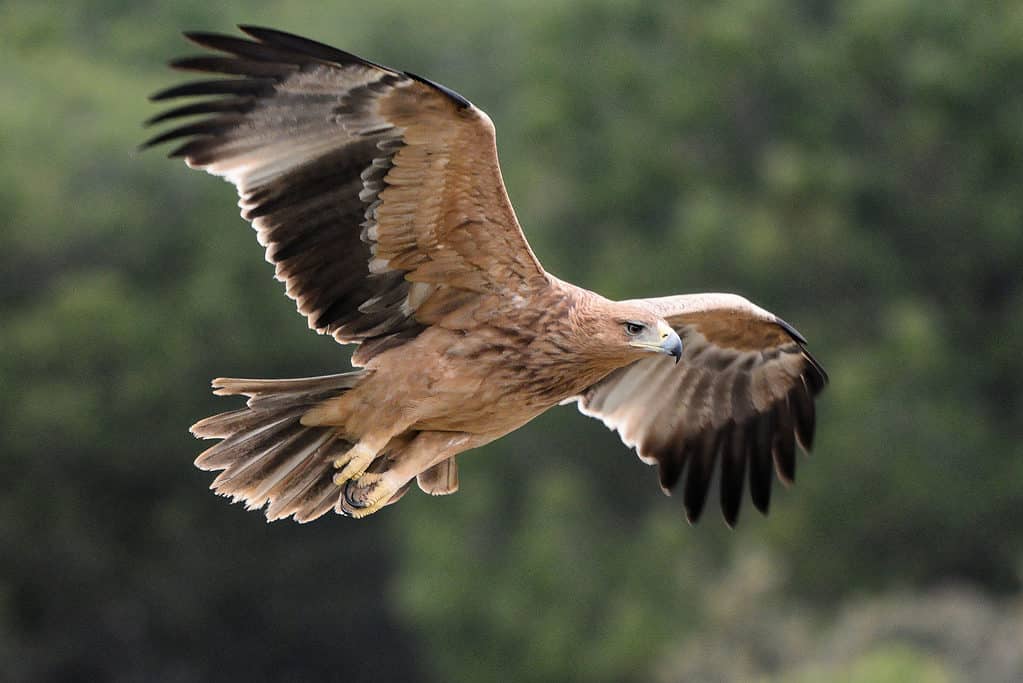
In the 1960s, only around 30 pairs of Spanish Imperial Eagles were left in the wild, but their population has recovered due to conservation efforts.
©LABETAA Andre/Shutterstock.com
| Rank | Bird |
|---|---|
| #1 | Jabiru |
| #2 | Galah |
| #3 | Vogelkop Superb Bird-of-Paradise |
| #4 | Imperial Amazon Parrot |
| #5 | California Condor |
| #6 | African Grey Parrot |
| #7 | Rufous Hummingbird |
| #8 | Ivory-Billed Woodpecker |
| #9 | Yellow-Eyed Penguin |
| #10 | Red-Headed Vulture |
| #11 | Kakapo |
| #12 | Philippine Eagle |
| #13 | Emperor Penguin |
| #14 | Wandering Albatross |
| #15 | Egyptian Vulture |
| #16 | Red Kite |
| #17 | Orange-Bellied Parrot |
| #18 | Harpy Eagle |
| #19 | Kagu |
| #20 | Great Hornbill |
| #21 | Scarlet Macaw |
| #22 | Toco Toucan |
| #23 | Hawaiian Crow |
| #24 | Whooping Crane |
| #25 | Spanish Imperial Eagle |
The photo featured at the top of this post is © Brian A Wolf/Shutterstock.com
Thank you for reading! Have some feedback for us? Contact the AZ Animals editorial team.






